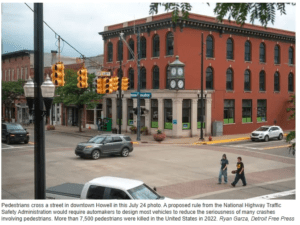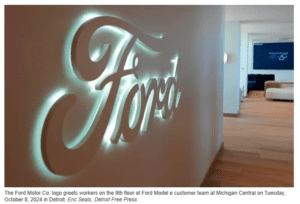No, Mercedes Benz will NOT take the blame for a Drive Pilot crash

Summary: Anyone turning on Mercedes Benz Level 3 Drive Pilot should presume they will be blamed for any crash, even though journalists are saying Mercedes Benz will take responsibility.
Drive Pilot usage while playing Tetris. (Source)
There seems to be widespread confusion about who will take the blame if the shiny new Mercedes Benz Drive Pilot feature is involved in a crash in the US. The media is awash with non-specific claims that amount to “probably Mercedes Benz will take responsibility.”
But the short answer is: it will almost certainly be the human driver taking the initial blame, and they might well be stuck with it — unless they can pony up serious resources to succeed at a multi-year engineering analysis effort to prove a design defect.
This one gets complicated. So it is understandable that journalists on deadline simply repeat misleading Mercedes Benz (MB) marketing claims without necessarily understanding the nuances. This is a classic case of “the large print giveth, and the small print taketh away” lawyer phrasing. The large print in this case is “MERCEDES BENZ TAKES RESPONSIBILITY” and the small print is “but we’re not talking about negligent driving behavior that causes a crash.”
The crux of the matter is that MB takes responsibility for product defect liability (which they have to any way — they have no choice in the matter). But they are clearly not taking responsibility for tort liability related to a crash (i.e., “blame” and related concepts), which is the question everyone is trying to ask them.
Like I said, it is complicated.
The Crash
Here is a hypothetical scenario to set the stage. Our hero is the proud owner of a Drive Pilot equipped vehicle, and has activated the feature in a responsible way. Now they are merrily playing Tetris on the dashboard, reading e-mail, watching a movie, or otherwise using the MB-installed software according to the driver manual. The car is driving itself, and will notify our hero if it needs help, as befits an SAE Level 3 “self-driving” car feature.
A crash to another vehicle happens ahead in the road, but the crashed vehicle is out of the flow of traffic. So our hero’s car sees a clear road ahead and does not issue a takeover request to the driver. Our hero is currently engrossed in watching a Netflix movie on the dashboard (using the relevant MB-approved app) full of explosions in an action scene, and does not notice.
Meanwhile, in the real world, a dazed crash victim child wanders out of their wrecked vehicle onto the roadway. But our hero’s MB vehicle has a hypothetical design defect in that it can’t detect children reliably.
Our hero’s vehicle hits and kills that child. (I emphasize this is a hypothetical, but plausible, defect. The point is that we, and the owner, have no way of knowing if such a defect is present right now. Other crash scenarios will play out in a similar way.)
Our hero then is charged by the police with negligent homicide (or the equivalent charge depending on the jurisdiction) for watching a movie while driving. Additionally a lawsuit for $100M is filed both against the driver and Mercedes Benz for negligent driving under tort law. The judge determines that Mercedes Benz did not have a duty of care to other road users under the relevant state law, so the tort lawsuit is changed to be just against the driver.
What happens to our hero next?
Will MB will step up and pay to settle the $100M lawsuit? Will they also volunteer to go to jail instead of our hero? I guess maybe? But they have not actually said they will do either of these things, because their idea of “responsibility” is talking about something entirely different.
Tort Law
I will say right here I am not a lawyer. So this is an engineer’s understanding of how the law works. But we are doing pretty basic legal stuff here, so probably this is about right. (If you are a journalist, contact law professor William Widen for his take.)
Tort law deals with compensation for a “harm” done to others. Put very simply, every driver has a so-called “duty of care” to other road users to avoid harming them. Failing to exercise reasonable care in a way that proximately causes harm can lead to a driver owing compensation under tort law. Unless there is a clear and unambiguous transfer of duty of care from our hero to the MB Drive Pilot feature, our hero remains on the hook under tort law.
The problem is that the duty of care remains with our hero even after activating Drive Pilot. Pressing a button does not magically make a human driver (who is still required to remain somewhat attentive in the driver seat) somehow not an actual driver under current law.
But, wait, you say. Mercedes says They Take Responsibility! (This message is currently being splashed across the Internet in breathless reviews of how amazing this technology is. And the technology is truly amazing.)
Well no, not according to tort law they don’t take responsibility. Instead, the MB position is that the driver retains the duty of care for potential harm to other road users when using their Level 3 Drive Pilot system — even while playing Tetris. Their representative admitted this on stage a couple weeks ago in Vienna Austria. I was in the crowd to hear it. Quoting from Junko Yoshida in that article: “Yes, you heard it right. Despite its own hype, Mercedes-Benz is saying that the driving responsibility still rests on the human driver in today’s L3 system.”
So what does MB mean when they “accept responsibility?” The answer is — they are not accepting the responsibility you think they are. In particular, they are not accepting liability that stems from negligent driving behavior.
Product Defect/Liability
A statement from Mercedes Benz issued to the press makes it clear that MB accepts responsibility for product defects, but not tort law liability. A key phrase is: “In the context of Drive Pilot, this means that if a customer uses the system as intended and instructed and the system fails to perform as designed, we stand behind our product.” (Source here.)
This means that in our hypothetical scenario, our hero can hire a lawyer, who then hires a team of engineers to look at the engineering of Drive Pilot to see if it “performs as designed.” Expect someone to pay $1M+ for this effort, because this is a full-on, multi-year product defect investigation. Maybe they find a defect. Maybe they don’t, even if a defect is really there. Or maybe they find a reproducible defect, and it is so complex the jury doesn’t buy the story. And maybe the performance as designed is that sensors will only detect 98% of pedestrians, and the victim in this tragic scenario is just one of that unlucky 2%.
Perhaps the owner manual says our hero should have been alert to dazed crash victims wandering in the travel lane. Even while playing Tetris. (That owner manual is not released yet, so we’ll just have to wait and see what it says.) In which case MB will blame our hero for being negligent — as if one is likely to notice a crash while watching the latest war movie with a high end sound system. And what if the owner didn’t bother to read the manual and instead just took the dealer and dozens of car journalists saying “MB accepts responsibility” at face value. (OK, well maybe that’s a different lawsuit. But we’re talking a legal mess here, not a clear acceptance of the duty of care for driving by MB.)
Who is holding the bag here?
It’s probably our hero, and not Mercedes Benz holding the bag. Even though our hero believed the MB marketing that said it was OK to play video games instead of looking out the front window, and believed their claims of superior engineering quality, and so on.
Maybe a product defect can be found. Finding one might influence a jury in a tort law case to blame MB instead of our hero. (But that’s not guaranteed. And what if the jury finds a reason to blame both?) Perhaps our hero has a robust umbrella insurance coverage instead of the state minimum that covers such a loss. Perhaps our hero is so broke they are “judgement proof” (no assets to collect — but owning a Mercedes Benz makes that less likely I’d think).
In effect, what we’ll see is that the human driver will almost certainly be presumed guilty of negligence in a crash if not paying attention to the road. The onus will be upon them to prove a design defect as a defense. This is difficult, expensive, time consuming, and overall not an experience I would wish on anyone.
And there is the specter of criminal liability for negligent homicide (or the equivalent). Depending on the state, our hero might be charged criminally based on being the operator or even just the vehicle owner (even if someone else is driving!). It depends. Nobody really knows what will happen until we see a case go through the system. But outcomes so far in Level 2 vehicle automation cases are not encouraging for our hero’s prospects.
Driving a Level 3 vehicle is only for the adventurous
We don’t know how this will turn out until a few such crashes make their way through the court system. But there is little doubt that it will be a rough ride for both the drivers and the crash victims after a crash while we see how this sorts out.
Anyone turning on Drive Pilot should presume they will be blamed for any crash, no matter what Mercedes Benz says. As even MB admits, the human driver retains the duty of care for safety to other road users at all times, just as in a Level 2 “autopilot”-style system. Marketing statements made by MB about giving time back to the driver don’t change that.
Who knows, maybe MB will decide to stand behind their product and pay out on the behalf of customers who find themselves embroiled in tort law cases. But they have not said they will do so. And maybe you believe that MB engineers are so good, that this particular software will have no defects AND will never mistakenly cause a crash. But that’s not a set of dice I’m not eager to roll.
This legal ambiguity is completely avoidable by establishing a statutory duty of care for computer drivers that assigns the manufacturer as the responsible party under tort and criminal law. But until that happens, our hero is going to be left holding the bag.
————————-
Phil Koopman has been working on self-driving car safety for more than 25 years. https://users.ece.cmu.edu/~koopman/






